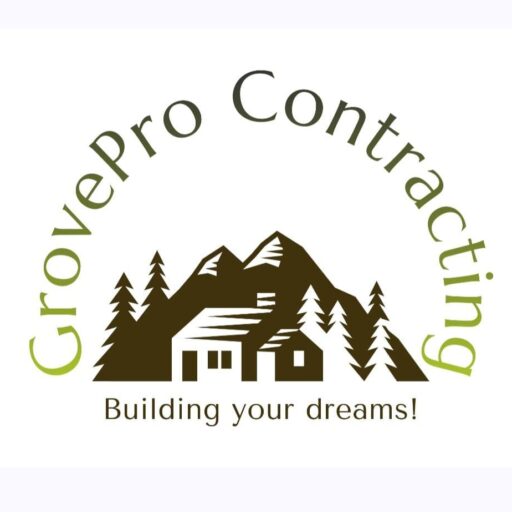GrovePro Contracting LLC
GrovePro Contracting Tiny Home Construction
GrovePro Construction is a leading company in the construction industry, specializing in ground removal and gravel placement. With years of experience and a team of skilled professionals, GrovePro Construction has established itself as a reliable and efficient partner for construction projects of all sizes.
Advanced Scheduling
Schedule your services quickly and easily. Start by requesting a quote at the bottom, or give us a call!
Satisfaction Guarantee
We will make sure the job is complete to your liking or plans.
Quality
After years of experience, you can depend on GrovePro Contracting to make sure the service is quality.
Tiny Home Construction by GrovePro Contracting
Tiny home living has seen a noticeable surge in popularity in the last few years. Living in smaller, more efficient spaces is a way to simplify life & lessen one’s impact on the environment, which is what’s driving this trend. This trend is a result of several factors, such as growing awareness of the importance of sustainable living practices, rising housing costs, and the desire for greater financial freedom. Due to the growing number of people and families choosing to downsize & lead more minimalist lives, there has been a notable increase in demand for tiny home construction.
Key Takeaways
- Tiny home living is on the rise, offering a more affordable and sustainable housing option.
- Tiny home construction offers benefits such as lower costs, reduced environmental impact, and increased mobility.
- Design and layout considerations for tiny homes include maximizing space, multi-functional furniture, and efficient storage solutions.
- Sustainable and eco-friendly practices in tiny home construction include using recycled materials, energy-efficient systems, and off-grid options.
- Challenges in building tiny homes can be overcome with innovative solutions, such as modular construction and creative design techniques.
Tiny homes are appealing because they offer a more economical and environmentally friendly form of housing. People can drastically cut their living expenses, such as rent or mortgage payments, utility bills, & maintenance costs, by opting to live in a smaller space. The environmental impact of tiny homes is further reduced by the fact that they are frequently built with sustainable materials & energy-efficient features.
Tiny home living has become popular among those looking to simplify their lives and leave a smaller environmental impact due to its affordability & sustainability. Living on a Budget. The financial benefits of both building & residing in tiny homes are among their greatest advantages. These houses require less materials to construct due to their smaller size, which lowers the cost of building. Tiny homes are also a more cost-effective housing option overall because their smaller square footage results in lower utility & maintenance costs.
A Lifestyle That’s Simpler. Building a tiny house also presents the chance for increased flexibility and independence. Living in a smaller space appeals to many people because it frees them up to simplify their lives and give more attention to the things that really matter to them. Flexibility and Mobility.
Because tiny homes are easily movable and can be built on wheels, they also present an opportunity for increased mobility. Those who value being able to travel or relocate without being confined to a traditional home may find this flexibility especially appealing. There are a few crucial factors to take into account when planning and constructing a tiny house. Given their small size, these homes require meticulous planning and use of every square inch to optimize both comfort & functionality. This necessitates carefully planning the layout and design while taking the occupants’ unique requirements and lifestyle into account.
Making use of multipurpose areas & furnishings is a crucial factor in the construction of tiny homes. Designing spaces with multiple uses in mind is crucial for optimizing the use of limited square footage. For instance, a dining table that folds down to make more workspace or a living room that serves as a guest bedroom are two examples. Also, maximizing space & establishing a more adaptable living environment can be achieved with furniture that is simple to store or rearrange.
The use of natural light and ventilation is a key factor in tiny home design as well. Since tiny homes are often smaller, it’s critical to make the most of the natural light and airflow to foster an open & roomy feeling. Large windows, skylights, and well-placed ventilation apertures can all help achieve this. It is feasible to design a tiny home that is more cozy and welcoming by including these components.
Since many tiny home adopters are driven by a desire to lessen their environmental impact, sustainability is an important factor to take into account when building a tiny home. Tiny house builders can reduce their carbon footprint and encourage a greener lifestyle by implementing a number of sustainable and eco-friendly building techniques. The use of eco-friendly building materials is a crucial component of sustainable tiny home construction. This covers materials with low environmental impact both during production & use, as well as those that are recyclable, renewable, or locally sourced. Reclaimed wood, bamboo, recycled metal, and low-VOC paints and finishes are a few examples of eco-friendly building materials that are frequently used in the construction of tiny homes.
Energy efficiency is a key factor to take into account when building a tiny home sustainably. It is possible to cut utility costs and energy consumption by implementing energy-efficient features like LED lighting, high-performance insulation, and energy-efficient appliances. Further reducing the environmental effect of tiny homes is the use of renewable energy sources, like solar or wind turbines, which provide clean, sustainable power. Although creating and residing in a tiny house has numerous advantages, there are particular difficulties that must be resolved while building.
To optimize functionality & comfort, creative solutions and meticulous planning are needed to overcome the primary challenge of limited space for living areas and storage. Ensuring that tiny homes adhere to zoning and building codes presents another challenge. Tiny homes might be governed by different laws pertaining to minimum square footage, foundation requirements, and zoning restrictions since they are frequently smaller than traditional houses.
Finding acceptable sites for tiny homes may become more difficult as a result, and more planning and permitting procedures may be necessary. Notwithstanding these difficulties, there are plenty of options for handling the particular issues involved in creating tiny homes. For instance, clever storage options like built-in bookcases, secret storage, & multipurpose furniture can help to optimize available space and lessen clutter. Also, navigating the complexities of building codes and zoning regulations can be made easier by collaborating with skilled contractors and designers who specialize in tiny home construction, ensuring that the project satisfies all requirements. Alternatives for Interior Customization.
Interior design is a field with virtually limitless possibilities. Whether they want an open-concept layout or private rooms, homeowners can construct a space that meets their needs by selecting from a range of floor plans & layouts. To further enhance personalization & customization, an endless array of finish options are available for flooring, countertops, cabinetry, & fixtures. Externalization. A tiny home’s exterior is equally as significant as its interior. Siding materials, roofing choices, window styles, and exterior finishes are all customizable to meet the unique needs and aesthetic preferences of homeowners.
Dealing with Professionals with Experience. Working with skilled builders and designers who specialize in tiny home construction is crucial to maximizing the customization possibilities for tiny homes. Homeowners can create a place that genuinely feels like home by doing this and exploring a wide range of customization options. There are a number of new developments & trends in the tiny home building industry as the desire for tiny home living grows. One noteworthy development is the growing trend of using technology to improve the comfort and usefulness of tiny homes. This includes cutting-edge space-saving techniques like retractable furniture and modular design elements, as well as smart home features like automated lighting and climate control systems.
The emphasis on environmentally friendly and sustainable building methods is another trend in tiny home construction. Tiny homes that incorporate eco-friendly building materials, renewable energy sources, and energy-efficient design elements are becoming more and more popular as people become more conscious of environmental issues. This pattern is probably going to continue as more people look for housing options that fit with their commitment to environmental stewardship and values.
A number of advancements in tiny house building are also anticipated in addition to these trends. This covers developments in off-grid living solutions that enable homeowners to live more independently, such as rainwater collection systems, composting toilets, and off-grid power generation options. Also, modular construction methods are becoming more and more popular because they offer chances for personalization and customization along with quicker and more effective building processes. In conclusion, people’s perspectives on housing and lifestyle options have changed as a result of the popularity of tiny home living. Tiny home construction is clearly here to stay given its many advantages, which include affordability, sustainability, flexibility, customization options, and upcoming innovative trends.
The future of tiny home construction appears bright, with countless opportunities to create distinctive, sustainable, and comfortable living spaces as more people look for alternatives to traditional housing options.
FAQs
What is a tiny home?
A tiny home is a small, often portable, dwelling that is typically under 400 square feet in size. It is designed to maximize space and minimize environmental impact.
What is tiny home construction?
Tiny home construction involves building or assembling a small, efficient living space that includes all the necessary amenities within a limited square footage.
What are the benefits of tiny home construction?
Some benefits of tiny home construction include lower construction costs, reduced energy consumption, minimal maintenance, and the ability to live a more minimalist lifestyle.
What are some common features of tiny homes?
Common features of tiny homes include lofted sleeping areas, multi-functional furniture, compact appliances, and creative storage solutions to maximize space.
What are some challenges of tiny home construction?
Challenges of tiny home construction may include zoning and building code regulations, limited space for amenities, and the need for creative design solutions to maximize functionality.
How can GrovePro Contracting help with tiny home construction?
GrovePro Contracting specializes in designing and building custom tiny homes, offering expertise in space optimization, sustainable materials, and innovative design solutions for efficient living spaces.
Locations
Located in Sault Ste. Marie, MI 49783
Serving Sault Ste. Marie and surrounding areas.
Hours
Monday — Saturday 7 a.m. — 6 p.m.
Jason Grove
General Contractor
Professional, courteous, and fast service is guaranteed.

